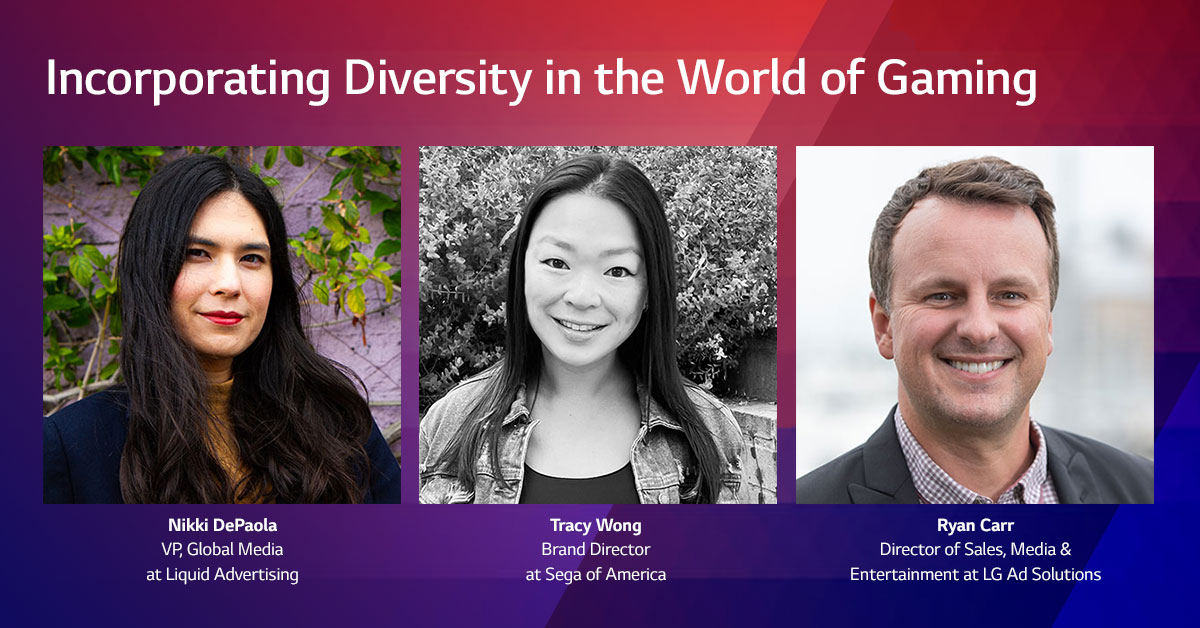Incorporating Diversity in the World of Gaming

From the Experts: Changing the Game with Diversity and Inclusion in Gaming
The gaming community is incredibly diverse, transcending age, gender, ethnicity, background, and ability. This creates a dynamic melting pot where individuals find common ground in the virtual worlds they explore. Brands that fail to reflect this diversity in their creative content miss the opportunity to forge connections with their audience and build a strong gamer fanbase and community.
In an effort to better understand how gaming brands can become more inclusive, we organized a webinar in November featuring gaming experts – Nikki DePaola, VP of Global Media at Liquid Advertising; Tracy Wong, Brand Director at Sega of America; and Ryan Carr, Sales Director of Media & Entertainment at LG Ad Solutions. The panel aimed to engage with industry specialists from diverse backgrounds who can personally and professionally advocate for the importance of diversity in gaming, shedding light on how brands can improve their approach.
If you missed the webinar, you can catch it on-demand or explore the key takeaways summarized below.
1. Level Up and Unlock Diversity in Gaming:
The potential for incorporating diversity into the gaming industry is vast. Within gaming, there exists tremendous opportunity to connect with audiences beyond demographic and cultural boundaries. Within the virtual landscape, game development teams have the ability to ensure that the diversity observed in real life is accurately mirrored in their games. Addressing gender biases is paramount. Typically, marketing messaging and audience targeting for gaming brands is catered towards men. However, 38% of console gamers in the United States are female (GWI, 2023), exposing a vast undertapped market. By confining the audience to an unrealistic stereotype, the risk is not only limiting the total addressable market but also neglecting potential revenue streams. Additionally, such practices exclude diverse audience segments that constitute a substantial portion of the player base.
“We’re not wanting to be here, just checking a box. And throughout our campaign, as we’re starting to build it even to the very end, we need to make sure we’re asking ourselves the right questions. [We have to ensure that] we’re casting females in our commercials, we’re featuring them in content, we’re engaging with them in the gaming community..making sure that the female consumer is top of mind, not an afterthought. [Additionally], are we investing in localizing our content and subtitling our content in different languages? Are we helping to underscore and champion accessibility? The more we can be authentic and the more that we can really create these [gaming] worlds that are very nuanced and clearly understand what each culture is about, the more that [players] we can bring in.” – Tracy Wong, Brand Director at Sega of America

2. Choose Your Players with Strategic Inclusivity
Embracing diversity doesn’t entail cramming every nationality or experience into a game, content, or creative. Such an approach risks coming off as tokenism. True inclusivity can take various forms. Leveraging technological advancements, brands can test a variety of Unique Selling Points (USPs) to gauge resonance with different audiences. A game can cater to multiple facets of the gamer’s personality and needs — fostering a sense of community, instilling a feeling of belonging, or captivating players with a challenging leveling system. Games that authentically feature a specific section of society are more impactful than those attempting to depict all of society merely for the sake of it. Brands need not exhaustively check every box. By strategically approaching audience segmentation based on motivations, inclusivity becomes a key focus, allowing for smarter messaging.
“Now we have technology that allows us to move away from assumptions and target actual gamers who are playing games that are similar to yours. So we don’t have to be exclusive anymore and make a decision between A or B. We can say why not both because we know [both] these audiences are playing these types of games. A good example of this is ACR technology, where we can detect what games people are playing. And if you like this action-adventure game, then we want to market this other action-adventure game to you regardless of if you’re male, female, non-binary.” – Nikki DePaola, VP of Global Media at Liquid Advertising

3. Creating Connections through Generations
Despite biased assumptions by brands that gaming profitability relates exclusively to the youth market, it’s crucial to recognize that a substantial 1 in 5 US gamers are aged 45 or above (MRI-Simmons, 2023). Many have a history of playing classic games like Mario, Sonic, and Final Fantasy in their youth. Recognizing the importance of this demographic’s familiarity with iconic IPs from their childhood, there’s a unique advertising opportunity to engage not only the current generation of gamers but also their parents. Unlike 20 years ago, when marketing focused on parents buying games for their children, today’s approach centers on passing the gaming torch, encouraging parents to engage in gaming with their kids or families. This presents a new strategy to reconnect with former gamers and create opportunities for shared experiences across generations.
The importance of representation in gaming cannot be overstated. Indie companies excel at fostering inclusivity, driven by passion projects where developers create games they personally would like to play and can see themselves in. This trend is influencing mainstream games, with larger studios recognizing the effectiveness of mixing genres and taking what might be considered “risks.” As indie successes demonstrate, these innovations lead to engaging conversations, particularly when it comes to diverse characters and storylines.
Ultimately, fostering diversity within the company is the first step to promoting inclusive conversations and content in games and virtual worlds. Achieving long-term, sustainable change in the industry hinges on intentional hiring practices. This foundation involves recruiting diverse talent and nurturing their growth beyond entry levels so that they can participate in leadership conversations. To be truly inclusive, those in power must recognize the importance of challenging one’s own perceptions and biases and provide a platform for diverse audiences to speak up.
For further insights on connecting with gaming audiences, please contact us through our contact page or email us at info@lgads.tv.
